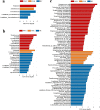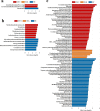Compositional and functional changes in the salivary microbiota related to oral leukoplakia and oral squamous cell carcinoma: a case control study
- PMID: 38115005
- PMCID: PMC10731685
- DOI: 10.1186/s12903-023-03760-y
Compositional and functional changes in the salivary microbiota related to oral leukoplakia and oral squamous cell carcinoma: a case control study
Abstract
Background: Oral squamous cell carcinoma (OSCC) is one of the most common malignant tumours with increasing incidence, and oral leukoplakia (OLK) has a strong tendency to undergo malignant transformation. The oral microbiota may influence oral cancer progression, but the salivary bacterial composition and functional changes in OSCC and OLK have not been comprehensively elucidated. Therefore, we compared salivary bacteria in OLK and OSCC patients with healthy controls (HC).
Methods: Metagenomic sequencing was used to compare the bacterial composition and functional changes of 18 OSCC patients, 21 OLK patients and 21 HC. Spearman correlation was used to identify possible associations between functions and bacteria.
Results: Gemella was the most differentially enriched genus in OSCC. At the species level, Streptococcus sp. NPS 308, Streptococcus agalactiae, Gemella haemolysans and Gemella morbillorum were slightly increased in OLK and OSCC. Kyoto Encyclopedia of Genes and Genomes (KEGG) results showed that OSCC was mainly associated with metabolism functions, including lipid metabolism, carbohydrate metabolism and glycan biosynthesis and metabolism. The synthesis and degradation of ketone bodies, cysteine and methionine metabolism and glycerolipid metabolism differed significantly among the three groups, and were highest in OSCC and lowest in HC. And G. haemolysans was significantly associated with these selected metabolic pathways.
Conclusions: Metagenomic analysis revealed significant differences in the salivary microbiota among OSCC, OLK and HC. Thus, salivary microbiota composition and functional changes may be associated with OSCC progression. Metabolism of nonessential amino acids such as cysteine and methionine in bacteria may play an important role in oral oncogenesis, and more studies of the mechanism between metabolisms of bacteria and oral oncogenesis are needed in the future.
Keywords: Gemella; Metagenomic sequencing; Oral leukoplakia; Oral microbiome; Oral squamous cell carcinoma; Saliva.
© 2023. The Author(s).
Conflict of interest statement
The authors declare no competing interests.
Figures






Similar articles
-
[Study on the invasion of Prevotella intermedia in tissues during carcinogenesis of oral mucosa].Zhonghua Kou Qiang Yi Xue Za Zhi. 2025 Mar 9;60(3):211-222. doi: 10.3760/cma.j.cn112144-20241212-00476. Zhonghua Kou Qiang Yi Xue Za Zhi. 2025. PMID: 40015702 Chinese.
-
[Determination of human papillomavirus in oral leukoplakia,oral lichen planus and oral squamous cell carcinoma].Beijing Da Xue Xue Bao Yi Xue Ban. 2016 Feb 18;48(1):84-8. Beijing Da Xue Xue Bao Yi Xue Ban. 2016. PMID: 26885914 Chinese.
-
Changes in oral microbial profiles associated with oral squamous cell carcinoma vs leukoplakia.J Investig Clin Dent. 2019 Nov;10(4):e12445. doi: 10.1111/jicd.12445. Epub 2019 Jul 24. J Investig Clin Dent. 2019. PMID: 31342659
-
The emerging role of oral microbiota in oral cancer initiation, progression and stemness.Front Immunol. 2023 Oct 26;14:1198269. doi: 10.3389/fimmu.2023.1198269. eCollection 2023. Front Immunol. 2023. PMID: 37954619 Free PMC article. Review.
-
Salivary Microbiota Composition in Patients with Oral Squamous Cell Carcinoma: A Systematic Review.Cancers (Basel). 2022 Nov 4;14(21):5441. doi: 10.3390/cancers14215441. Cancers (Basel). 2022. PMID: 36358859 Free PMC article. Review.
Cited by
-
State of the Art in the Diagnosis and Assessment of Oral Malignant and Potentially Malignant Disorders: Present Insights and Future Outlook-An Overview.Bioengineering (Basel). 2024 Feb 28;11(3):228. doi: 10.3390/bioengineering11030228. Bioengineering (Basel). 2024. PMID: 38534502 Free PMC article. Review.
-
Salivary Metabolomics Discloses Metabolite Signatures of Oral Leukoplakia with and Without Dysplasia.Int J Mol Sci. 2025 Jul 7;26(13):6519. doi: 10.3390/ijms26136519. Int J Mol Sci. 2025. PMID: 40650295 Free PMC article.
-
Effect of a Novel Food Rich in Miraculin on the Oral Microbiome of Malnourished Oncologic Patients with Dysgeusia.Cancers (Basel). 2024 Oct 8;16(19):3414. doi: 10.3390/cancers16193414. Cancers (Basel). 2024. PMID: 39410033 Free PMC article.
-
The Global Trends and Advances in Oral Microbiome Research on Oral Squamous Cell Carcinoma: A Systematic Review.Microorganisms. 2025 Feb 8;13(2):373. doi: 10.3390/microorganisms13020373. Microorganisms. 2025. PMID: 40005740 Free PMC article. Review.
-
Nanocellulose-modified electrodes for simultaneous biosensing of microbiome-related oral diseases biomarkers.Mikrochim Acta. 2025 Feb 11;192(3):141. doi: 10.1007/s00604-025-07011-5. Mikrochim Acta. 2025. PMID: 39932508
References
-
- Al-Hebshi NN, Borgnakke WS, Johnson NW. The microbiome of oral squamous cell carcinomas: a functional perspective. Curr Oral Health Rep. 2019;6(2):145–60. doi: 10.1007/s40496-019-0215-5. - DOI
Publication types
MeSH terms
Substances
Grants and funding
- PKUSSNMP-201907/the 2021 National Program for Multidisciplinary Cooperative Treatment on Major Diseases
- PKUSSNMP-202109/the 2022 National Program for Multidisciplinary Cooperative Treatment on Major Diseases
- PKUSS20170104/Young People Fund of Peking University School and Hospital of Stomatology
- PKUSSNCT-23B11/Program for New Clinical Techniques and Therapies of Peking University School and Hospital of Stomatology
LinkOut - more resources
Full Text Sources
Medical

